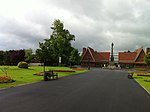Boer War Memorial, Crewe
Buildings and structures completed in 1903CreweEngvarB from January 2014Grade II listed buildings in CheshireMonuments and memorials in Cheshire ... and 1 more
Second Boer War memorials

The Boer War Memorial, also known as the South African War Memorial, stands in a prominent position in Queens Park, Crewe, England. It was erected in memory of local soldiers who had served or fallen in the Boer War, and consists of a bronze statue of soldier in uniform standing on a column on a stone plinth. The monument was unveiled in 1903, and contains plaques with the names of those who were lost in the war. It is recorded in the National Heritage List for England as a designated Grade II listed building.
Excerpt from the Wikipedia article Boer War Memorial, Crewe (License: CC BY-SA 3.0, Authors, Images).Boer War Memorial, Crewe
Queens Park Drive,
Geographical coordinates (GPS) Address External links Nearby Places Show on map
Geographical coordinates (GPS)
| Latitude | Longitude |
|---|---|
| N 53.09695 ° | E -2.46846 ° |
Address
War Memorial
Queens Park Drive
CW2 7SX , Coppenhall
England, United Kingdom
Open on Google Maps









